On August 8, 2025, the Project 23470 tugboat Kapitan Ushakov began listing sharply to starboard while undergoing final outfitting near the pier of the Baltic Shipyard in St. Petersburg.
Efforts by shipyard teams and emergency services to stabilise the vessel continued throughout the night but ultimately failed. By the morning of August 9, the tugboat had capsized and settled on the seabed adjacent to the pier.
Built according to the modern Project 23470 design, Kapitan Ushakov measured nearly 70 metres in length, 15 metres in beam, and displaced approximately 3,200 tons. It was launched in June 2022 at the Yaroslavl Shipbuilding Plant and transported to St. Petersburg for completion. The design goals for this class include towing vessels, offshore structures, ice navigation up to Arc4, firefighting, search-and-rescue missions, and even accommodating a helipad.
The Russian Investigative Committee has opened a pre-investigation under regulations governing construction safety violations. Early findings indicate flooding originated in the auxiliary machinery compartment, triggering the fatal list. The vessel was slated to join the Northern Fleet’s 566th support ship detachment in Murmansk and become operational by the end of 2024.
This incident raises questions about safety oversight during critical outfitting stages and could carry broader implications for Russia’s naval readiness. The loss of a nearly completed tug underscores the potential impact of procedural lapses, highlighting how construction-stage mishaps can remove valuable assets from service before they even enter the fleet.
A naval engineer at a major Scottish shipyard, who asked to remain anonymous, described the incident as a rare but telling failure in basic shipyard practice.
“A ship in this stage of construction is essentially in a controlled environment,” he said. “Systems are tested step-by-step, and the stability envelope is well understood. For a vessel of this size to flood and capsize alongside the pier, something went very wrong in either the way work was sequenced or the way safety margins were monitored.”
While acknowledging that accidents can happen in any yard, the engineer stressed that the circumstances here make the loss especially damaging. “When a vessel has already been launched and is in final fitting out, most of the high-risk structural work is over. Any flooding should be containable. That a 70-metre tug could not be stabilised overnight tells you that either watertight integrity wasn’t maintained or the crew on scene lacked the right equipment or training to counter the list quickly.”
He warned that the reputational fallout could linger long after the vessel is salvaged. “Navies rely on auxiliary vessels like tugs to keep operations running, and losing one before commissioning is a black eye for any fleet. It undermines confidence in shipyard processes and raises uncomfortable questions about quality control. Even if they refloat her, the fact she went down in port before ever joining the fleet will be remembered as a costly and avoidable failure.”


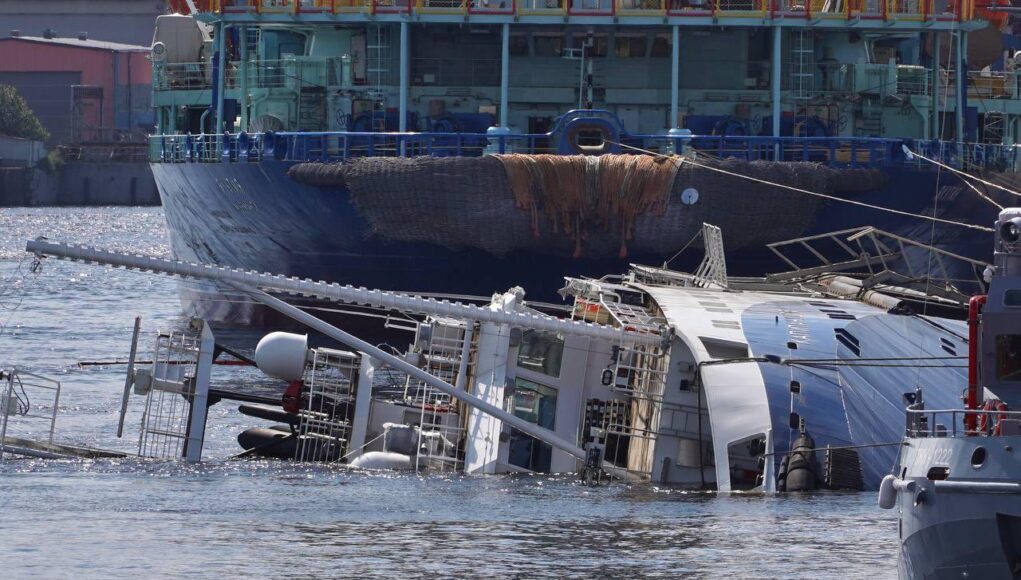
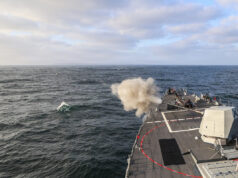
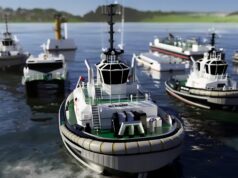
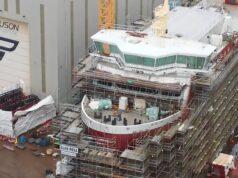
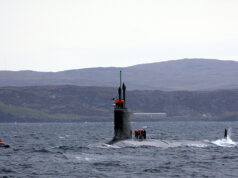
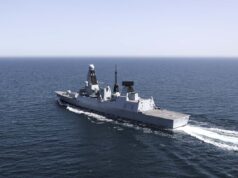


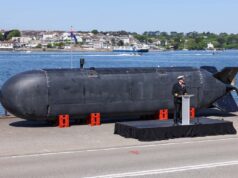
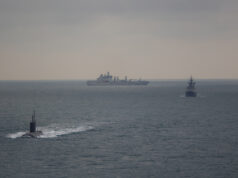
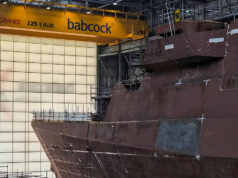

Adversary or not, when I see incidents like this I just hope nobody was onboard.
Meanwhile, they kill hundreds of Ukrainians every single day.
The only good orcZ are fertiliser for the sunflower 🌻 crop in eastern Ukraine. Saves the red army from paying family benefits when they’re MIA or lost at sea. ruz mir.
I don’t think those responsible are going to get away from the gulags because of this latest russian navy fiasco.
Pride of the Russian Navy.
If you can’t send a warship to sea without a tug in case it breaks down and your tugs are sinking it is probably time for some naval officers to avoid high buildings, specifically windows.
Haha brilliant 😄👌🏾 And true…
Western Front time for whoever was drunk and left the seacocks open before leaving the ship.
😁😁off to the gulag
If you can’t send a warship to sea without a tug in case it breaks down and your tugs are sinking it is probably time for some naval officers to avoid high buildings, specifically windows.
Much of the Russian Navy is soviet era and therefore too old. Now the Russians appear to have design / build issues.
This has been mis reported as a failure. It’s actually a new ship launching process, they have taught the North Korean’s how to do it as well 😀
Oh I see. Perhaps they should try launching the next one on it’s port side – see how that goes for them. Odds are they will get it right eventually.
I believe one of there ships the kommuna was launched in 1913 and is still sailing on apparently its a submarine rescue ship and to be fair I struggle to think of any navy that has more sub accidents than the Russian navy so you would think they might invest in maybe a newer ship lol
I wonder what proportion of these ‘ships’ have actually left port in the last thirty years. Also I’m dubious that there would be any crews capable of sailing them especially as their excuse for a carrier’s crew transferred to Ukraine – if I remember correctly?
Hmmm…perhaps payback by SBS/MI6 for the Barrow dockyard fire, affecting the completion schedule for HMS Achilles? 🤔😉 Probably not, but worth the Orcs noting that gray zone warfare can be a double edged sword.
Seems like an oddly small and unassuming target to go after, especially if this is an isolated incident. Furthermore, although it’s fun to imagine, I don’t see the government risking all that international backlash when the Russian navy looks as though it might sink itself anyway.
You forget that tugboats are THE most importantly vessels in the Russian navy. It’s how they get all of their other surface vessels back to port.. 😂
😂😁👍 (Good on you, mate! Better comment than mine.)
leh,
Yes, very probably not reality. But am beginning to understand how rumors/conspiracy theories originate. 😉
Yes, who knows why the RF shadow fleet has so many unfortunate maintenance incidents in their engine room.
Could it be AFU divers, you say?
You might think that, but I couldn’t possibly comment..
Machinery is Lubed with Vodka.
UKEs getting everywhere today. I hope some Rus did the right thing and went down with their tug.
Doesn’t inspire confidence for Russian crews. This was meant to be artic capable.
Well ice wouldn’t have fitted through the hole no doubt so would operate safer in that environment.
Oh dear. How sad. Never mind!
BSM Williams!
Shame. Hope many more Russian ships face the same fate
Oh dear, how sad, never mind! I see the Russians are excelling once more in their skills and drills!
I didn’t realise the Russians were making various types of subs
Fully consistent with the corruption, incompetence and dishonesty of the terrorist state, their failing economy and military.
Yes, comrade chief engineer, we checked the Hull welding integrity and it was excellent…
Aside from fleet operations, the increasing RF activity in the Arctic is of both environmental and military concern. Just as they disregard agreements when convenient ( Budapest memorandum) the concensus that Arctic is a scientific not commercial area is further eroded by Arctic capable vessels.
The fewer, the better!
‘Tug’ lol yeah, just like the Japanese killing whales for ‘scientific research’.
What a load of baloney.
I do sometimes wonder if we worry too much about these clowns? Problem is they have so many many clowns and then when they use them up they seem to have even more. How many times have experts at RUSI and other bullshit factories told us the Russian’s are on their knees and now they are signing more contracts for overseas sales of military hardware. Sanctions? What sanctions? The boats sinking…..okay build another one. Yes I guess we should be worried.
The Russians are struggling with their corrupted defence industrial base and this incident makes them look like a right bunch of clowns, but they are an aggressive bunch of clowns who have no regard for the old geopolitical rules that were as an important a part of keeping the peace as Mutually Assured Destruction was / is. The risk of an ‘accident’ is at it’s high level since the early1980’s given the reckless way in which Moscow operates, just ask the people of Salisbury. Given Russia’s huge nuclear arsenal, even if only half of them actually work half the time, they could still ruin anyone’s day.
Clowns they may seem, but their reckless disregard for consequences and provided the leadership are safely tucked up in their deep bunkers they are quite capable of doing something wildly stupid. They are dangerous and unpredictable bunch of clowns who need to be deterred on every level. Sadly, I do not think that the West provides a sufficiently robust deterrence, just pop over to Navy Lookout and read their latest summary article on the state of the RN… The West is scrambling to rearm and finding it is not so easy to rebuild your armed forces at the same time as you need to rebuild your industrial base!
Given the relationship between China and Russia and having read the NL article, I am left wondering who are the biggest clowns.!?
CR